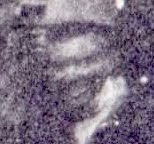
I can't pinpoint the moment in my childhood when I first became obsessed with the Civil War. I do know that I was in middle school when I fervently began reading every Civil War book I could get my hands on. It was around this point that I first turned a page to find a photograph of a teenage Confederate soldier lying dead in the trenches. The caption indicated he was fourteen years old and had been killed by bayonet during the Union assault on Fort Mahone, part of the defenses of Petersburg, Virginia. Something changed. I don't know what happened; maybe this marked the first moment that the Civil War became real for me. Not really became, it was more like a flicker, a glimpse.
I've been struggling to understand my fixation with this image ever since. Fixation is the wrong word. Inability to escape? "Haunted" sounds cliched, but I can't think of a better word. The indescribable, familiar strangeness I've encountered studying history ironically drove me away from history as a discipline and into poetry. Fourteen years after I first encountered the dead Rebel, his likeness became the driving force behind my first book, Jerusalem Plank Road. By that time I had learned that the photographer, Thomas Roche, likely had no knowledge of the boy's age and conceivably even invented his cause of death. The only thing we can know with any amount of certainty is that this anonymous young man died early in his life, a week before Lee's surrender at Appomattox. He lost his youth and his future for a cause that was already lost. Then a photographer came along and immortalized his corpse. We choose what to take from this. A reminder of war's horror? A memorial to an act of bravery?
This was nothing new.

Consider Joseph Bara, the fourteen-year-old French soldier killed by Breton royalists in 1793. Robespierre, architect of the Terror, declared him a martyr to the Republic. His story grew into legend, his death the subject of various works of art, including a painting by Jacques-Louis David. Today, who can tell who Joseph Bara really was, what he thought, said, did? Or the pain and fear he may have felt in his last moments. Or how his mother and father took the news, or whether his comrades were haunted by what they saw and the memory of the friend they lost. Joseph Bara ceased to exist as a person. Yet he lives now in art. Is that even life? I understand why some people hate artists. It infuriates me that Roche lied to add a little more "color" to his photograph. It seems tragically ironic that the image of Joseph Bara's death was used as propaganda to inspire more to kill and to die. Yet wouldn't it be equally egregious if his death served as nothing but a warning that war is horrible? I grappled with this as the young Confederate came to "life" in some of the characters in my work. I didn't want him to be a symbol or a warning or a juxtaposition. I wanted him to be a boy. But the idealization of boyhood in art also troubled me. Boys aren't angels and they should never represent innocence alone. They are walking, running, dancing, killing, living paradoxes. Which makes their deaths all the more difficult to bear. Wilfred Owen was undoubtedly moved by the beauty of the boys he saw dying around him. I believe it made his compassion (and his outrage) all the more powerful.
Sometimes I think I just wanted the Rebel boy to breathe. I've considered writing him without the war. Like Bara without his uniform. Or his death, for that matter.

Mort de Bara by Jacques-Louis David

Pro Patria by Emile Edmond Peynot

No comments:
Post a Comment